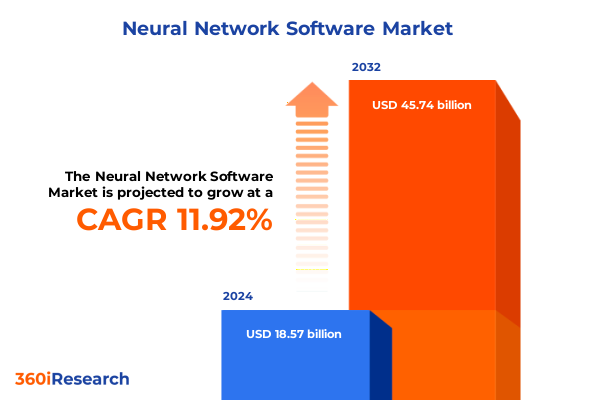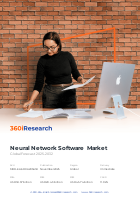The Neural Network Software Market size was estimated at USD 18.57 billion in 2024 and expected to reach USD 20.43 billion in 2025, at a CAGR of 11.92% to reach USD 45.74 billion by 2032.

Exploring How Advanced Neural Network Software Powers the Next Wave of Artificial Intelligence Solutions and Elevates Performance Across Industries
Neural network software has emerged as a critical enabler for artificial intelligence solutions across every industry, from healthcare diagnostics to financial services fraud detection. By abstracting complex mathematical operations into reusable frameworks and platforms, these software tools allow data scientists, developers, and enterprises to experiment with deep learning architectures at unprecedented speed and scale. As the volume of available data continues to expand and computational resources become increasingly accessible, neural network software has evolved from academic curiosity into indispensable components of modern technology stacks.
This introduction lays the groundwork for a detailed exploration of the forces shaping this dynamic market. It highlights how the open source movement has democratized access to high-performance neural network frameworks, while cloud-native deployments and MLOps platforms simplify the end-to-end lifecycle of AI applications. With major technology vendors and innovative startups vying for leadership, the neural network software landscape has become a vibrant ecosystem of specialized tools, prebuilt models, and managed services. The following sections delve into the transformative shifts, policy influences, segmentation nuances, regional variations, competitive dynamics, and strategic imperatives that define the industry today.
Revealing the Technological and Market Disruptions That Are Reshaping the Neural Network Software Ecosystem for Future Artificial Intelligence Adoption
Over the past two years, the neural network software market has been redefined by the convergence of robust MLOps platforms, edge AI integrations, and the proliferation of open source frameworks. Organizations now demand seamless orchestration of the ML lifecycle, and tools like Kubeflow and MLflow have become central to production workflows by offering version control, experiment tracking, and scalable pipeline management on Kubernetes environments. Meanwhile, AI-augmented MLOps capabilities are being embedded within developer environments to automate error detection, resource optimization, and model validation, thereby reducing manual overhead and improving reliability.
Simultaneously, the rise of edge computing has accelerated the need for lightweight neural network runtimes capable of real-time inference on resource-constrained devices. Solutions such as TensorFlow Lite and ONNX Runtime power applications ranging from autonomous vehicles to smart manufacturing, enabling low-latency decision making without constant cloud connectivity. As a result, software frameworks are increasingly optimized for quantization, hardware acceleration, and compatibility with specialized AI chips.
In parallel, open source AutoML toolkits have gained momentum by abstracting neural architecture search and hyperparameter tuning. Libraries like Microsoft’s Neural Network Intelligence automate critical training tasks, empowering data science teams to accelerate model experimentation while maintaining reproducibility and governance standards. Together, these technological and market shifts are reshaping the competitive landscape, driving innovation in both enterprise-grade platforms and community-driven projects.
Assessing the Comprehensive Effects of 2025 United States Trade Tariffs on Neural Network Software Development, Supply Chains, and Industry Innovation
In 2025, sweeping United States tariffs introduced new complexities for the neural network software industry by disrupting hardware supply chains and elevating input costs. The administration’s imposition of duties on electronic imports triggered one of the steepest market reactions since 2020, with the Nasdaq dropping nearly 6% and the S&P 500 falling 4.8% immediately after the announcement on April 3, 2025. Although finished semiconductor chips were temporarily exempt, many critical components such as silicon wafers, rare earth metals, and packaging materials faced tariffs up to 30%, creating cost escalation that reverberated through GPU and ASIC suppliers vital to AI inference and training workloads.
Deep Insights into Neural Network Software Market Segmentation by Offering, Organization Size, Components, Deployment Modes, Learning Types, Verticals, and Applications
A nuanced view of the neural network software market emerges when dissected by offering type, organization size, component suite, deployment mode, learning approach, vertical application, and functional use case. Commercial off-the-shelf frameworks and platforms compete alongside bespoke custom solutions, catering to entities that require tightly tailored AI stacks. Large enterprises often combine robust commercial offerings with expansive integration services, whereas small and medium enterprises rely on modular, self-service platforms that enable rapid deployment without extensive internal expertise.
From a component perspective, services span consulting, integration and deployment, maintenance and support, and training, which complement solutions delivered as frameworks-either open source or proprietary-or as comprehensive platforms. Deployment modes range from public cloud environments to hybrid architectures and on premises installations, reflecting risk profiles related to data sovereignty, latency, and security. Learning modalities encompass reinforcement, semi supervised, supervised, and unsupervised approaches, each optimized for specific problem domains and data availability constraints.
End-user verticals such as automotive, banking and financial services, government, healthcare, manufacturing, retail, and telecommunications demonstrate varying levels of maturity in neural network adoption, influenced by regulatory requirements and legacy infrastructure. Across these sectors, applications including image recognition, natural language processing, predictive analytics, recommendation engines, and speech recognition highlight the breadth of neural network software capabilities, underscoring the importance of matched toolsets and expert services to drive measurable business outcomes.
This comprehensive research report categorizes the Neural Network Software market into clearly defined segments, providing a detailed analysis of emerging trends and precise revenue forecasts to support strategic decision-making.
- Offering Type
- Component
- Learning Type
- Organization Size
- Deployment Mode
- Application
- Vertical
Examining the Distinct Adoption Patterns, Growth Drivers, and Dynamics Shaping Neural Network Software Markets in the Americas, EMEA, and Asia-Pacific Regions
Regional dynamics play a pivotal role in influencing neural network software adoption, with the Americas leading in cloud-first implementations bolstered by hyperscale providers and extensive data center footprints. In Europe, Middle East and Africa, heightened regulatory oversight on data privacy and cross-border data flows shapes preferences for hybrid and on premises deployment modes, driving demand for integrated services that ensure compliance. Across Asia-Pacific, rapid digitization initiatives and government-driven AI strategies fuel widespread interest in cost-effective, scalable platforms that can operate both at the edge and within centralized computing environments.
Investment priorities also differ by region. In the Americas, the emphasis lies on scaling AI operations at hyperscaler rates, while EMEA stakeholders prioritize localized support, data governance, and ethical AI frameworks. Meanwhile, Asia-Pacific organizations often focus on automation to manage large volumes of unstructured data, with a growing appetite for pre-trained models that accelerate time to value. These regional nuances underscore the need for adaptable neural network software offerings that align with policy frameworks, infrastructure capabilities, and cultural expectations in each market.
This comprehensive research report examines key regions that drive the evolution of the Neural Network Software market, offering deep insights into regional trends, growth factors, and industry developments that are influencing market performance.
- Americas
- Europe, Middle East & Africa
- Asia-Pacific
Analyzing the Strategic Approaches, Competitive Positioning, and Collaboration Models of Leading Neural Network Software Providers in an Evolving AI Landscape
Leading neural network software providers are distinguished by their ecosystem breadth, developer engagement models, and strategic alliances. Global technology firms such as Google, Microsoft, and AWS leverage their cloud infrastructure and open source contributions to drive framework adoption and managed service growth, enabling enterprises to deploy complex models without deep in-house infrastructure investments. Specialized vendors like H2O.ai and DataRobot focus on automated machine learning and no-code interfaces that democratize access to advanced algorithms, targeting businesses seeking rapid experimentation and lower barriers to entry.
Hardware-centric companies, including Nvidia and Intel, play a critical role by optimizing runtimes and libraries-such as CUDA and oneAPI-to accelerate neural network performance. They collaborate closely with software framework developers to ensure compatibility with the latest GPU and specialized AI chip architectures. Meanwhile, consultancies and system integrators such as Accenture and Capgemini provide implementation services that bridge the gap between proof-of-concept projects and large-scale rollouts, embedding neural network solutions within broader digital transformation initiatives.
This comprehensive research report delivers an in-depth overview of the principal market players in the Neural Network Software market, evaluating their market share, strategic initiatives, and competitive positioning to illuminate the factors shaping the competitive landscape.
- Alibaba Group Holding Limited
- Alphabet Inc.
- Amazon.com, Inc.
- Apple Inc.
- Baidu, Inc.
- BrainChip Holdings Ltd.
- C3.ai, Inc.
- Cerebras Systems Inc.
- DataRobot, Inc.
- Graphcore Limited
- H2O.ai, Inc.
- Hewlett Packard Enterprise Company
- Intel Corporation
- International Business Machines Corporation
- Meta Platforms, Inc.
- Microsoft Corporation
- Mythic, Inc.
- NVIDIA Corporation
- OpenAI, Inc.
- Oracle Corporation
- Palantir Technologies Inc.
- Salesforce, Inc.
- SAP SE
- Tencent Holdings Limited
- UiPath Inc.
- Vectara, Inc.
Strategic Recommendations for Industry Leaders to Navigate Disruption, Drive Innovation, and Capitalize on Neural Network Software Opportunities in 2025 and Beyond
Industry leaders should prioritize a multi-pronged strategy to navigate the evolving neural network software market. First, investing in diversified deployment options-including cloud, hybrid, and on premises-will mitigate risks associated with changing regulatory landscapes and supply chain disruptions. Organizations must also cultivate partnerships with both hyperscale cloud providers and specialized hardware vendors to secure early access to performance enhancements and co-development initiatives.
Outlining the Rigorous Research Methodology Employed to Ensure Accuracy, Depth, and Reliability in Neural Network Software Market Intelligence
This research employed a rigorous, multi-tiered methodology to ensure the highest levels of accuracy and relevance. Primary research included structured interviews with neural network software buyers, developers, and C-level decision-makers to capture firsthand insights into adoption drivers and pain points. Secondary research encompassed an exhaustive review of industry publications, technology white papers, regulatory filings, and vendor collateral to contextualize market developments and policy shifts.
This section provides a structured overview of the report, outlining key chapters and topics covered for easy reference in our Neural Network Software market comprehensive research report.
- Preface
- Research Methodology
- Executive Summary
- Market Overview
- Market Insights
- Cumulative Impact of United States Tariffs 2025
- Cumulative Impact of Artificial Intelligence 2025
- Neural Network Software Market, by Offering Type
- Neural Network Software Market, by Component
- Neural Network Software Market, by Learning Type
- Neural Network Software Market, by Organization Size
- Neural Network Software Market, by Deployment Mode
- Neural Network Software Market, by Application
- Neural Network Software Market, by Vertical
- Neural Network Software Market, by Region
- Neural Network Software Market, by Group
- Neural Network Software Market, by Country
- Competitive Landscape
- List of Figures [Total: 34]
- List of Tables [Total: 837 ]
Summarizing Core Insights and Strategic Takeaways to Guide Decision-Making in the Expanding Neural Network Software Market Landscape
In summary, neural network software stands at the forefront of artificial intelligence evolution, offering unparalleled capabilities to process complex data and drive intelligent decision-making. The convergence of advanced MLOps platforms, edge-native runtimes, and open source frameworks has created a dynamic ecosystem in which both established incumbents and agile newcomers compete. However, external factors such as trade policies and regional regulations underscore the need for strategic agility and technological adaptability.
Engage with Ketan Rohom to Acquire Comprehensive Neural Network Software Market Insights and Unlock Strategic Growth Opportunities Today
To explore the full suite of insights, data analyses, and strategic guidance contained in this comprehensive neural network software market report, please reach out to Ketan Rohom, Associate Director of Sales & Marketing at 360iResearch. He will provide personalized assistance, walk you through the report’s key value drivers, and facilitate your access to proprietary intelligence designed to accelerate your organization’s AI initiatives. Connect with Ketan Rohom today to secure your copy and transform your strategic planning with actionable, expert-validated research tailored to the neural network software landscape.

- How big is the Neural Network Software Market?
- What is the Neural Network Software Market growth?
- When do I get the report?
- In what format does this report get delivered to me?
- How long has 360iResearch been around?
- What if I have a question about your reports?
- Can I share this report with my team?
- Can I use your research in my presentation?




